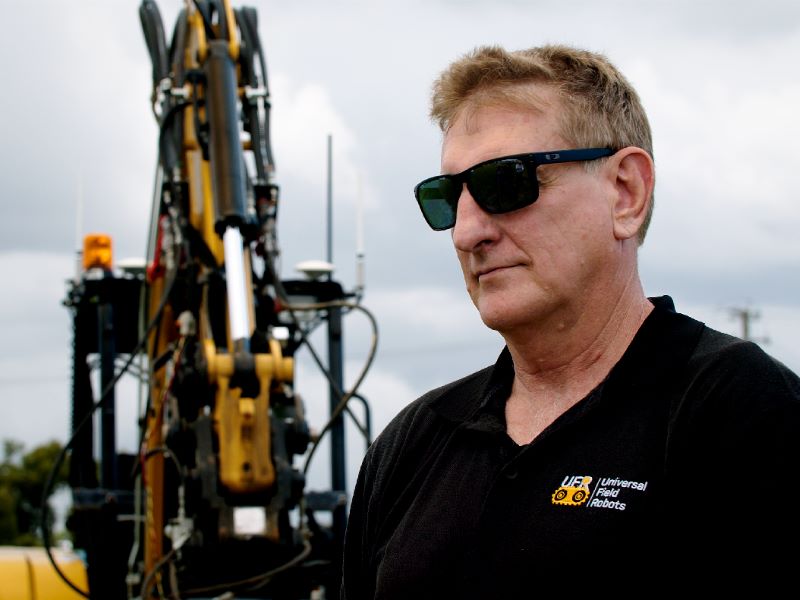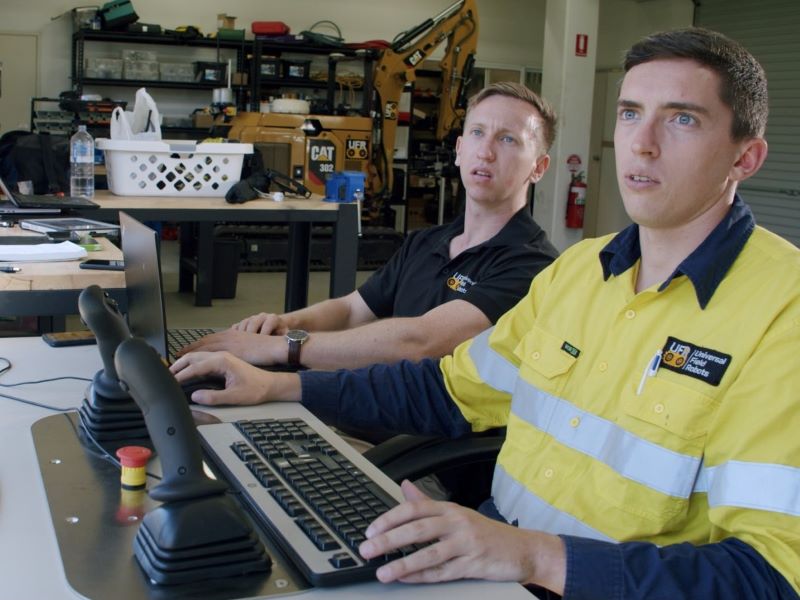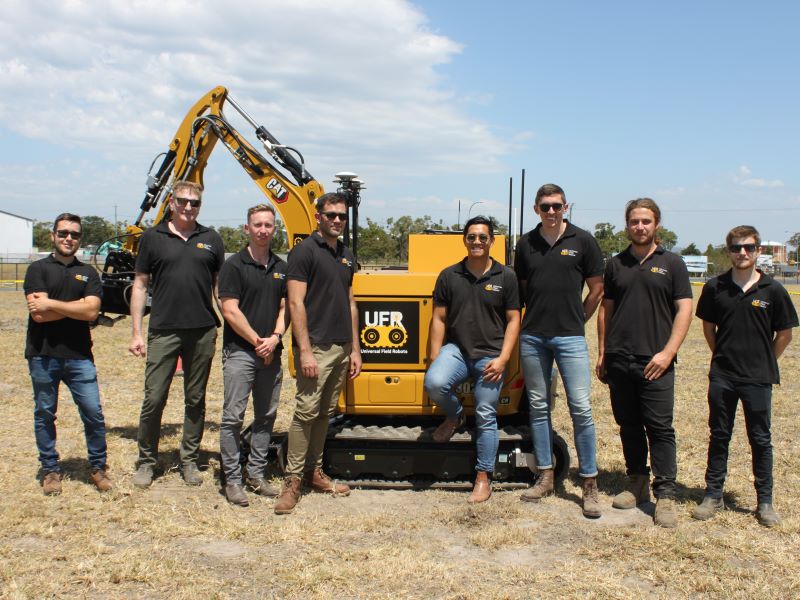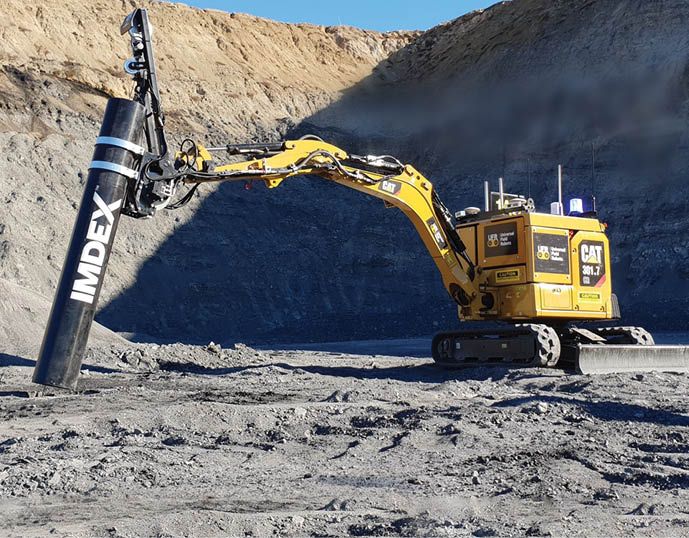Autonomous robots being used today in dangerous precision blasting work in Chile started in an engineer’s backyard in Brisbane six years ago.
But getting to this point – an Australian startup exporting advanced technology – required a level of government support and leadership the founder says has disappeared in recent years.
In 2015, Jeff Sterling was looking to expand the engineering consultancy he had been running for three decades because he was increasingly being “squeezed” by management consultants higher up the chain.
“I needed to change direction a bit, so I started thinking … and out of that the genesis of the robotics started,” Mr Sterling says.
“And then I became quite enthusiastic about it — obsessed is probably more accurate — and started up the robotics company.”
His company, Universal Field Robots (UFR), specialises in autonomous heavy machinery and now employs around 20 mechanical and mechatronic engineers, software developers and salespeople.

What began in Mr Sterling’s garage quickly led to a three-tonne prototype.
“It didn’t fit in the garage,” Mr Sterling tells InnovationAus.
“That was a first prototype. We bought a second-hand machine, we built that [into a robot] and ran it up and down the driveway.”
UFR now builds fully autonomous robots with various industrial capabilities. The startup takes apart Caterpillar excavators and modifies and re-engineers them with sensors and automation software.
Its sweet spot in the resources market — which is already well advanced in autonomous options — is myriad “little” automated tasks in between the large driverless mine trucks and robotic drilling.
The company’s flagship product is the E20C, a two-tonne robotic platform which can be equipped with various attachments to perform a variety of tasks.
An early UFR prototype was presented at the state’s leading robotics conference in 2018, and garnered attention for automated avocado picking. Commercial inquiries followed for agricultural applications and a proposal to use the machines to construct solar farms.
But it wasn’t until it received a federal Accelerating Commercialisation grant, which provided UFR with matched funding of $833,000 and expert advice, that the company started to find its way through the commercialisation “valley of death”.

“We’d been successful with the technical stuff – we haven’t failed in anything in the technical stuff,” Serling says. “But the commercial part is the challenging piece.”
UFR was advised through the accelerating commercialisation grant officer that agriculture was too fragmented and conservative a market for its particular robotics. The grant also meant the solar farm project, which was scrapped when a partner fell over, became a “speculative” bet rather than a death knell, Mr Sterling said.
“If we didn’t get the [Accelerating Commercialisation] grant, we could have very well fizzled at that stage.”
The grant required a fair degree of fortunate timing because of the way it was structured.
“You’ve got this little, tiny window of time when you’ve got a product that is almost ready to go to the market, but you haven’t sold any. And you’ve got to be able to demonstrate you’ve got enough money, but you haven’t got enough money to do it on your own.
“So you’ve got that tiny little window,” Mr Sterling said.

The capital allowed the company, which is still bootstrapping, to keep going through several “false starts”. Eventually, through a hackathon, it connected with IMDEX Limited, an ASX-listed global mining technology company that would later become UFR’s foundational customer.
IMDEX uses the E20C today to deploy its subterranean sensors with a robot known as the BLAST DOG, which is used to help optimise blasting based on high-resolution three-dimensional material models built from sensor data.

IMDEX is now testing nearly a dozen BLAST DOGs in Chile and Australia in a priority project to commercialise the technology with its own clients. The company says there is an addressable market of around 6,000 blasts per day in mining and construction, but the information used to determine location and strength is relatively basic.
“What we do is put the sensors down the blast holes and collect big data on what is below the ground. And then they can do all sorts of clever things.”
The sensor data allows IMDEX to adjust blasting to different levels of the hole based on the different material. The more sophisticated blasting ultimately creates much more manageably sized material when it is later excavated.
The results have helped UFR to gain recognition in Australia’s mining equipment, technology and services, or METS, sector. Last year, UFR secured $1 million in funding from the METS Growth Centre, IMDEX, and an industry partner for a new project to take the technology to underground mines.
The project is one of just four selected by METS for support under its collaborative project fund. Together, the projects are projected to generate revenue over $100 million for the local sector.
UFR will bring its BLAST DOG technology to Australian underground mines, where Mr Sterling says operators want to push automation even further.
“They want to try and pull people back from unsafe activities. And the endgame is to be able to do everything between the drilling and actually loading the explosives autonomously.”
The UFR founder said he was fortunate to have decades of experience and his own capital to set up the company, which also took advantage of the support and momentum established at the federal level by Malcolm Turnbull’s National Innovation and Science Agenda and the state’s Advance Queensland initiative.
“We went through three accelerators and we took every opportunity that was there. And out of that, maybe 10 per cent of [the opportunities] turn into something useful. But that 10 per cent was enough to get us going.”
Today, Mr Turnbull is long gone and with him, critics say, any real national leadership on innovation. The Queensland program is also suffering from a lack of political attention, according to those involved in its heyday.
Mr Sterling said government support has “gone backwards” in recent years. Too often programs are focusing on research without development, he says, and leadership is sorely missing.
“The thing that’s missing is the policy,” Mr Stirling said.
“We should be really putting the foot down on developing technology and technology businesses in Australia, and it’s not coming. There’s no leadership on it at the moment at a federal level or even at state level in Queensland anymore.”
Do you know more? Contact James Riley via Email.

